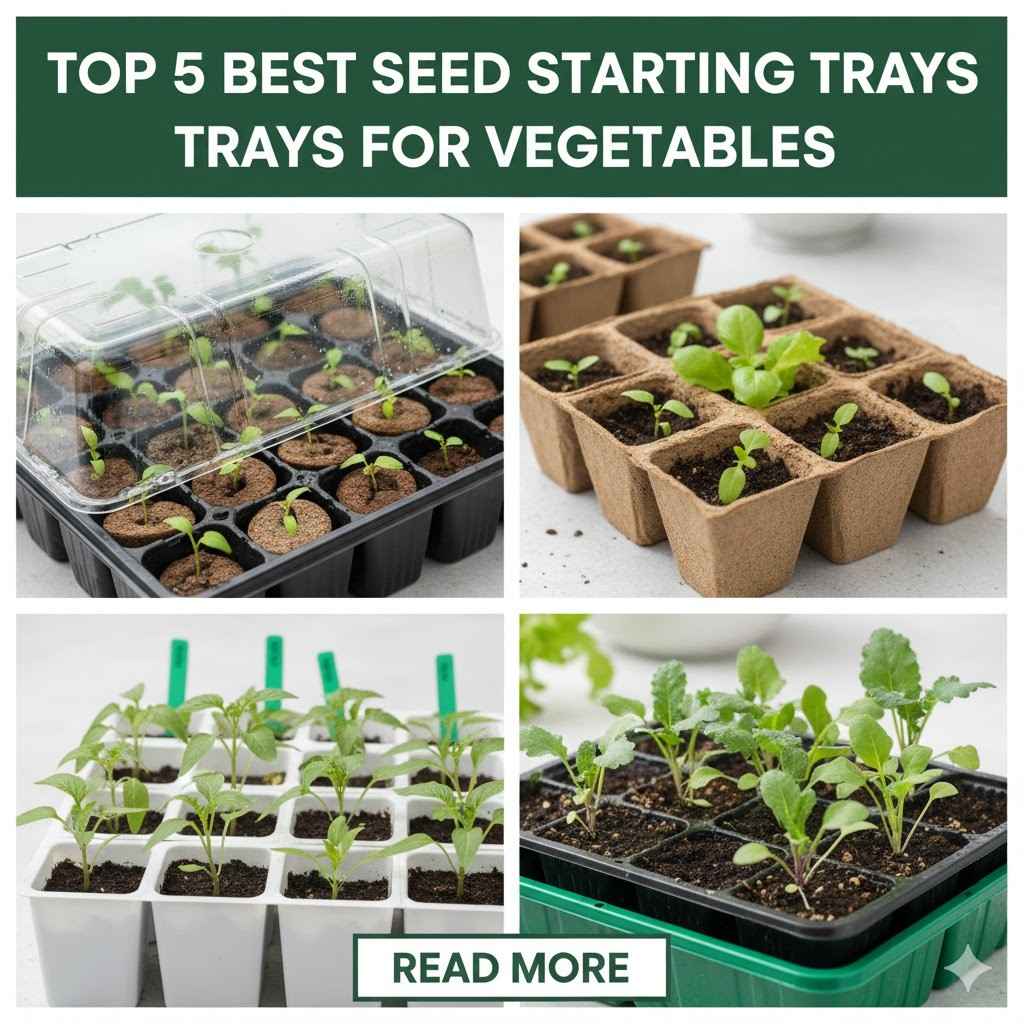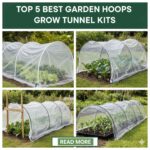Seed starting trays are essential tools for vegetable gardeners, allowing you to kickstart your plants indoors before transplanting them to the garden. These trays provide a controlled environment for germination, protecting seeds from harsh weather and pests while promoting healthy root development. In 2025, advancements in materials like durable plastics, silicone, and humidity-controlled designs have made seed starting more efficient and eco-friendly. This guide ranks the top 5 best seed starting trays for vegetables, focusing on those suitable for common crops like tomatoes, peppers, lettuce, and cucumbers. We prioritized trays with good drainage, reusability, and user feedback from online sources. Included are technical specifications, practical applications, pros/cons, user considerations, direct Amazon product links, an FAQ section, educational video resources, and tips on maintenance and trends. Selections are based on product listings, expert reviews, and customer experiences from sites like NBC Select and Better Homes & Gardens.
1. Burpee SuperSeed Seed Starting Tray (36-Cell Reusable Tray for Versatile Vegetable Germination)
The Burpee SuperSeed 36-Cell Tray, ideal for starting vegetable seeds indoors.
This 36-cell tray from Burpee is designed for easy indoor seed starting, with flexible pop-out cells that make transplanting stress-free for vegetable seedlings.
Technical Specifications:
- Number of Cells: 36
- Material: Food-grade silicone cells with rigid plastic frame
- Dimensions: Approximately 10″ x 20″ tray size; each cell 1.5″ x 1.5″ x 2″
- Features: Molded corner slots for drainage and aeration, alphanumeric row labeling for organization, dishwasher-safe for easy cleaning, reusable design
Practical Applications: Ideal for starting a variety of vegetables like tomatoes, peppers, and herbs. Users report high germination rates for crops that need an early indoor start, covering small to medium home gardens with up to 36 plants per tray. Based on feedback, it excels in controlled environments like windowsills or under grow lights, reducing transplant shock for healthier yields.
Pros:
- Flexible cells prevent root damage during transplant
- Excellent drainage reduces overwatering issues
- Reusable and easy to clean, promoting sustainability
- Includes a Plant-o-Gram diagram for tracking seedlings
Cons:
- Smaller cell size may not suit larger-rooted veggies like squash without upsizing
- Higher initial cost compared to basic plastic trays
User Considerations: Perfect for beginner gardeners starting vegetables indoors. Consider pairing with a heat mat for faster germination in cooler climates. Check seed packets for specific timing, such as starting tomatoes 6-8 weeks before the last frost. If cells feel too small, opt for the XL version for deeper roots.
2. MIXC Seed Starter Tray Kit with Humidity Dome (120 Cells Total for High-Volume Vegetable Starting)
The MIXC Seed Starter Kit with adjustable humidity dome for optimal vegetable germination.
This kit includes 10 trays with humidity domes, offering 120 cells for large-scale vegetable seed starting in a mini-greenhouse setup.
Technical Specifications:
- Number of Cells: 120 total (12 cells per tray x 10)
- Material: Durable plastic with transparent dome
- Dimensions: Each tray approx. 7″ x 5.5″ x 2.3″; cells 1.5″ deep
- Features: Adjustable humidity vents on dome, base tray for water catchment, drainage holes in cells, stackable design
Practical Applications: Great for vegetable gardeners planting multiple varieties, such as lettuce, cucumbers, and beans. The humidity dome creates a microclimate that boosts germination for moisture-loving seeds, allowing coverage of larger gardens. Reviews highlight its use in starting up to 120 seedlings at once, ideal for succession planting.
Pros:
- Humidity control improves germination rates for vegetables
- Affordable multi-pack for bulk starting
- Easy to monitor and adjust moisture levels
- Includes base to prevent mess from drainage
Cons:
- Domes can fog up, requiring occasional venting
- Plastic may become brittle after multiple seasons if not stored properly
User Considerations: Suited for intermediate gardeners with space for multiple trays. Use in well-lit areas or under LED lights for best results. For vegetables like peppers, maintain 70-80°F for optimal sprouting. Clean thoroughly between uses to avoid mold.
3. Industry Standard Grower’s Supply Seedling Starter Trays (720 Cells for Budget Vegetable Propagation)
The Industry Standard 720-Cell Trays, perfect for large-scale vegetable starting on a budget.
These bulk trays provide 720 cells across 120 six-cell packs, offering an economical option for extensive vegetable seed starting.
Technical Specifications:
- Number of Cells: 720 total (6 cells per tray x 120)
- Material: Thin, flexible plastic
- Dimensions: Each six-pack tray approx. 7″ x 3.5″; cells 1.75″ deep
- Features: Drain holes in each cell for proper water management, stackable for storage, includes 5 plant labels
Practical Applications: Best for high-volume vegetable growing, such as starting rows of carrots, onions, or broccoli. Gardeners use them for commercial-like setups in home greenhouses, with feedback noting efficient space use for transplant-ready seedlings in 4-6 weeks.
Pros:
- Extremely cost-effective for large quantities
- Good drainage prevents root rot in vegetables
- Lightweight and easy to handle
- Includes labels for organization
Cons:
- Thinner material may crack with rough handling
- Not as reusable as thicker trays; best for one or two seasons
User Considerations: Ideal for budget-conscious beginners or those expanding their vegetable garden. Pair with a watering tray to catch excess. For denser-rooted veggies like tomatoes, transplant early to avoid crowding. Store flat to prevent warping.
4. Hoss Heavy-Duty Seed Starting Trays (162-Cell Trays for Durable Vegetable Root Training)
The Hoss Heavy-Duty 162-Cell Tray, built for long-lasting vegetable seed starting.
These ultra-durable 162-cell trays (sold in packs of 5) are built to last, with features promoting strong root growth for vegetables.
Technical Specifications:
- Number of Cells: 162 per tray (810 total in 5-pack)
- Material: Injected-molded heavy-duty plastic
- Dimensions: Standard 10″ x 20″ tray; cells approx. 0.75″ x 0.75″ x 1.5″
- Features: Vertical root training ribs for aeration and drainage, lifetime durability guarantee, made in USA
Practical Applications: Excellent for starting fine-seeded vegetables like lettuce, kale, and herbs in large batches. Users praise its longevity for annual vegetable gardens, covering acres with healthy transplants that resist shock.
Pros:
- Extremely durable and long-lasting
- Root training improves plant health for vegetables
- Good aeration reduces damping-off disease
- Value for money over time
Cons:
- Smaller cells limit use for large-seeded veggies
- Heavier than standard trays
User Considerations: Recommended for experienced gardeners seeking investment pieces. Use with soil blocks or pellets for easy filling. For vegetables like beans, consider larger cells; otherwise, it’s perfect for succession sowing.
5. Hanaoyo Reusable Seed Starter Tray (60 Cells with Flexible Cells for Easy Vegetable Transplanting)
The Hanaoyo 60-Cell Reusable Tray, flexible for vegetable seedlings.
This 5-pack of 12-cell trays offers 60 cells total, with silicone flexibility for gentle handling of vegetable seedlings.
Technical Specifications:
- Number of Cells: 60 total (12 per tray x 5)
- Material: Food-grade silicone cells with thickened plastic base
- Dimensions: Each tray approx. 9″ x 6″; cells 1.5″ x 1.5″ x 2″
- Features: Pop-out cells for easy transplant, drain holes, reusable and dishwasher-safe, includes 10 labels and tools
Practical Applications: Suited for starting vegetables like strawberries, tomatoes, and pumpkins indoors. Feedback indicates quick cleanup and reuse, making it efficient for seasonal vegetable rotations in small spaces.
Pros:
- Flexible silicone reduces transplant stress
- Strong and tear-resistant construction
- Versatile for various vegetable seeds
- Comes with accessories for convenience
Cons:
- May require a separate humidity dome for best results
- Slightly pricier per cell than bulk options
User Considerations: Great for eco-conscious users growing organic vegetables. Ensure good lighting for seedlings; pair with grow lights if needed. Wide applications for fruits and veggies make it adaptable.
Frequently Asked Questions (FAQ)
Based on common queries from gardening forums and user reviews, here are answers to key questions about seed starting trays for vegetables:
- What size cells are best for vegetable seeds? Smaller cells (1-1.5″) work for most veggies like lettuce, but deeper ones (2″+) are better for tomatoes or peppers to allow root development. Choose based on transplant timing.
- Are reusable trays worth the investment? Yes, especially for annual use—durable options like Hoss or Burpee last years, reducing waste and costs over time.
- How do I prevent mold in seed trays? Ensure good drainage and ventilation; use domes sparingly and sterilize trays between uses with a bleach solution.
- Can I use these trays outdoors? They’re best indoors or in greenhouses, but hardy models like MIXC can handle sheltered outdoor starting in mild weather.
- What’s the ROI for home vegetable starting? Starting from seeds can save 50-70% on plant costs; a $20 tray kit might yield hundreds in produce.
Educational Video Resources
To learn more about using seed starting trays for vegetables, check these educational videos available as of October 2025. Search terms are provided for YouTube, as links change frequently:
- Seed Starting Basics with Trays: Covers filling, watering, and transplanting vegetables; search “Epic Gardening seed starting trays tutorial”.
- Best Trays for Vegetable Germination: Reviews reusable options like Burpee; search “Gardenary best seed trays for veggies 2025”.
- Humidity Dome Usage Guide: Explains controlling moisture for peppers and tomatoes; search “Bootstrap Farmer humidity dome tips”.
- Reusable Tray Maintenance: Demonstrates cleaning and storage; search “Hoss Tools durable seed tray care”.
Additional Considerations
Maintenance Tips
- Clean trays with mild soap or dishwasher after each use to prevent disease.
- Store in a dry, flat area to avoid warping; stack reusable ones carefully.
- Check for cracks annually and replace if drainage is compromised.
- For silicone trays, avoid sharp tools to prevent tears.
Regulatory Guidance
- No strict regulations for home use, but opt for BPA-free materials for food safety.
- In the US, follow local guidelines for organic certification if selling produce.
- Use eco-friendly trays to minimize plastic waste; biodegradable alternatives reduce environmental impact.
Future Trends
In 2025, seed trays are trending toward sustainable materials like recycled plastics and smart features (e.g., built-in sensors for moisture). Expect more AI-integrated kits for automated watering, based on ongoing discussions in gardening communities.
Conclusion
These top 5 seed starting trays for vegetables in 2025 cater to various budgets ($15–$60) and scales, from small home setups to larger gardens. Whether you prefer the flexible Burpee for easy transplants or the durable Hoss for longevity, each offers reliable germination for crops like tomatoes and lettuce. Pairing these trays with complementary gardening tools like grow tunnels, gloves, plant stands, sprinklers, or sprayers can enhance your gardening efficiency and yield. Explore related guides for additional equipment to optimize your vegetable garden:
- Top 5 Best Garden Hoops Grow Tunnel Kits
- Top 5 Best Waterproof Long Gardening Gloves for Women
- Top 5 Best Indoor Plant Stands for Multiple Plants
- Top 5 Best Lawn Sprinklers for Low Water Pressure
- Top 5 Electric Garden Sprayers
- Top 5 Agricultural Drones
Refer to the FAQs, videos, and tips for success, and always verify compliance with local practices. Use the product links to purchase and start your vegetable garden today.







